Add this eBook to your basket to receive access to all 91 records. Our indexes include entries for the spelling platten. In the period you have requested, we have the following 91 records (displaying 81 to 90): These sample scans are from the original record. You will get scans of the full pages or articles where the surname you searched for has been found. Your web browser may prevent the sample windows from opening; in this case please change your browser settings to allow pop-up windows from this site. Boys entering Gresham's School
(1944)
The Sir John Gresham Grammar School at Holt in Norfolk was founded by sir John, who bought the manor house there in 1546 to convert it into a school, and building work had started by 1555. To celebrate the quatercentenary in 1955, a history of the school written by the Reverend C. L. S. Linnell was published, together with an Alumni Greshamienses, a register of boys entering the school from 1562 to 1954, compiled by A. B. Douglas. The materials to hand for the register for the early years were slight; the first coherent lists of boys survive only from 1729, and then are fitful, with little detail, and largely missing from 1784 to 1803; however, from 1810 onwards the names of boys' parents are usually recorded. The register is arranged chronologically by year (and from 1900 by term - L, Lent; M, Michaelmas; S, Summer), and then alphabetically by surname (in capitals) and christian name(s). Where known, year of birth is then given (in brackets), names, addresses and occupations of parents. From 1900 onwards there are italic abbreviations for sporting achievements at school (h, hockey colours; VIII, shooting colours; S, first-class swimmer; XI, cricket colours; XV, football colours), and p for house prefect and P for school prefect; then (in italics) information about the boy's adult life, and his address (where living) at the time of publication. Finally, on the right hand side of the page, in italics, is given the year of his leaving the school. Most detail is absent before 1810; and, of course, for the boys still at school in 1955, or only recently left, there are no details of future career; nor are there the usual details about their parentage. From 1898 onwards day boys are noted with an italic D (N means Newquay dayboy); and from 1900 onwards the school houses are shown (B, Bengal Lodge; F, Farfield; H, School House or Howson's; K, Kenwyn; O, Old School House; W, Woodlands); and, for the junior school, c, Crossways; k, Kenwyn; o, Old School House). | Sample scan, click to enlarge
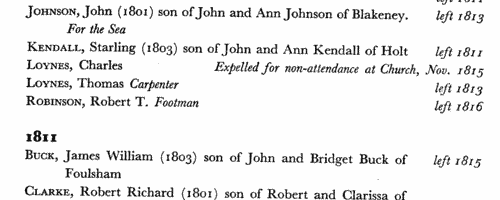
| Prominent Inhabitants of Birmingham
(1949)
The Birmingham Post Year Book and Who's Who is an annual publication seeking to give comprehensive information about the city's organizations and its eminent residents. The Year Book has separate sections dealing with the City Council; the Municipal Elections; Municipal Departments; The High Court of Justice; Members of Parliament for the City; Political Associations; Government Departments; Trade and Industry; Birmingham Consular Association; Banks and Branches; Birmingham Stock Exchange; Restaurants and Cafes; Health; Churches and Religious Congregations; Freemasons; Education; Child Care; Youth; Cultural Activities; British Broadcasting Corporation; Sports and Pastimes; Philanthropic and Kindred Institutions; County and Kindred Societies; International Societies; United Nations Association; Clubs; Transport; The Forces; Toc H.; Royal Antediluvian Order of Buffaloes; Electricity and Gas Boards; Law List; Chartered Accountants; Incorporated Accountants; Certified and Corporate Accountants; Chartered Secretaries; Surveyors, Auctioneers, Land Agents and Valuers; Architects; Civil Engineers; Mechanical Engineers; Electrical Engineers; and Old Boys' Associations. For most organizations, names and addresses of secretaries and other officers are given. Full lists of professional people are given in their sections, with addresses. Then there is the Who's Who in Birmingham, which (with an In Memoriam section for those who had died in the last year) usually gives full name (surname first, in capitals, in bold), date and place of birth (and often father's name), if married the year and name of spouse (and sometimes father's name); numbers of sons and daughters; a brief description of career, recreations, and current address. | Sample scan, click to enlarge
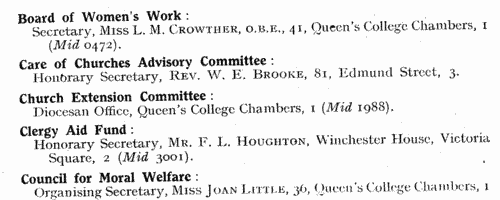
| Boys entering Gresham's School
(1951)
The Sir John Gresham Grammar School at Holt in Norfolk was founded by sir John, who bought the manor house there in 1546 to convert it into a school, and building work had started by 1555. To celebrate the quatercentenary in 1955, a history of the school written by the Reverend C. L. S. Linnell was published, together with an Alumni Greshamienses, a register of boys entering the school from 1562 to 1954, compiled by A. B. Douglas. The materials to hand for the register for the early years were slight; the first coherent lists of boys survive only from 1729, and then are fitful, with little detail, and largely missing from 1784 to 1803; however, from 1810 onwards the names of boys' parents are usually recorded. The register is arranged chronologically by year (and from 1900 by term - L, Lent; M, Michaelmas; S, Summer), and then alphabetically by surname (in capitals) and christian name(s). Where known, year of birth is then given (in brackets), names, addresses and occupations of parents. From 1900 onwards there are italic abbreviations for sporting achievements at school (h, hockey colours; VIII, shooting colours; S, first-class swimmer; XI, cricket colours; XV, football colours), and p for house prefect and P for school prefect; then (in italics) information about the boy's adult life, and his address (where living) at the time of publication. Finally, on the right hand side of the page, in italics, is given the year of his leaving the school. Most detail is absent before 1810; and, of course, for the boys still at school in 1955, or only recently left, there are no details of future career; nor are there the usual details about their parentage. From 1898 onwards day boys are noted with an italic D (N means Newquay dayboy); and from 1900 onwards the school houses are shown (B, Bengal Lodge; F, Farfield; H, School House or Howson's; K, Kenwyn; O, Old School House; W, Woodlands); and, for the junior school, c, Crossways; k, Kenwyn; o, Old School House). | Sample scan, click to enlarge
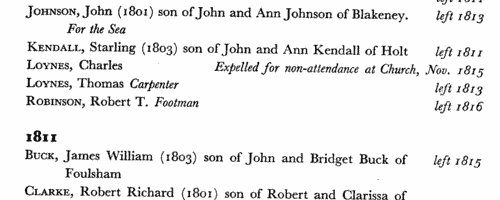
| British Civil Servants
(1953)
The British Imperial Calendar lists civil servants in Britain, arranged according to the organizational structure of the state, and shows their qualifications and salaries. | Sample scan, click to enlarge
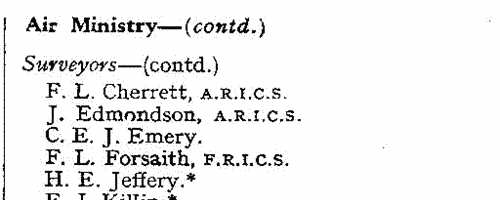
| Inhabitants of Liverpool
(1955)
Kelly's (Gore's) Directory of Liverpool and District includes this alphabetical list of residents and traders, with names, addresses, and (where applicable) telephone numbers. Covering a large area around Liverpool, the directory includes Bootle, Birkenhead and Wallasey, and thus the populous areas of southwest Lancashire and of the Wirral peninsula of Cheshire. | Sample scan, click to enlarge

| Residents of Southend-on-Sea
(1955)
Kelly's Directory of Southend-on-Sea, Leigh-on-Sea, Westcliff and Neighbourhood for 1955 lists private residents by surname, christian name(s), house, street and area, for the whole of the county borough of Southend-on-Sea in Essex, including Westcliff-on-Sea (W), Prittlewell, North Shoebury, South Shoebury or Shoeburyness (S. & S. S), Milton, Southchurch, Southchurch Wick, Thorpe Bay (T. B), Leigh-on-Sea (L), Nobles Green and Eastwood (E). | Sample scan, click to enlarge

| Residents of Southampton
(1956)
Kelly's Directory of Southampton and Neighbourhood for 1956 lists private residents by surname, christian name(s), house, street and area, for the whole of the county borough of Southampton in Hampshire, including Portswood, Freemantle, Shirley, Bassett, Bitterne, Bitterne Park, Itchen, Sholing, North Stoneham, South Stoneham, Swaythling, Weston with Newtown, Woolston, Redbridge and West End. | Sample scan, click to enlarge

| Anglican clergy
(1957)
Crockford's Clerical Directory listed all Anglican clergy in the British Isles, India, Africa, Canada, the West Indies, Europe, Australasia and South America. The 77th issue, for 1957-58, is based on returns from all the individuals listed, and was deemed correct as of 30 September 1957. The details given are: name (surname first, in capitals) in bold; name of theological college and/or university, and degrees, with years; a bold d followed by year and diocese signifies date of ordination as deacon and by which bishop; then a bold p, similarly for ordination as priest; posts (C: curate; I: incumbent; V; vicar; R: rector) with parishes and years; address; telephone number; and lists of books &c. where appropriate. In the case of the man then holding an English, Irish, Scottish or Welsh benefice, additional details are given - a bold P signifies the patron of the advowson; then the income, with items such as Q. A. B. (Queen Anne's Bounty), Eccles(iastical) Comm(issioners), Fees, e. o. (Easter Offerings), Pew Rents, T(ithe) R(ent) C(harge), Gl(ebe), &c. | Sample scan, click to enlarge
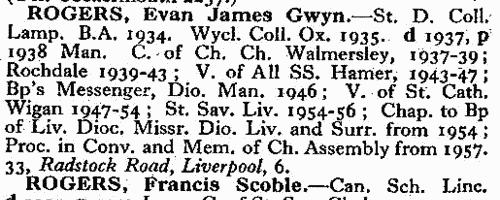
| Inhabitants of Bedford
(1957)
Private residents and traders from Kelly's Directory of Bedford | Sample scan, click to enlarge
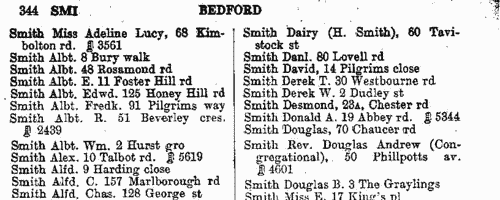
| Royal Naval Volunteer Reserve Officers
(1957)
The Navy List for 1957, corrected to 18 January 1957, includes this alphabetical catalogue of 'Officers on the Active List of the Royal Naval Volunteer Reserve and other Naval Volunteer Reserves'. The first column gives surname and initials, with name of ship, or CCF for Combined Cadet Force, or SCC for Sea Cadet Corps, in square brackets, and in round brackets if in the Royal Australian Naval Volunteer Reserve (RAN), Royal Marine Forces Volunteer Reserve (RMFVR), Royal New Zealand Naval Volunteer Reserve (RNZN), Hong Kong Royal Naval Volunteer Reserve (Hg Kg), Fiji Royal Naval Volunteer Reserve (Fiji), Indian Naval Volunteer Reserve (IN), South African Naval Forces (SA), Pakistan Naval Volunteer Reserve (PN), East Africa Royal Naval Volunteer Reserve (EA), Mauritius Naval Volunteer Reserve (Maur), Malayan Royal Naval Volunteer Reserve (Mala), Royal Ceylon Volunteer Naval Reserve (RCyN), or Sierra Leone Naval Volunteer Reserve (Sa Ln). The second column is rank, with a profusion of abbreviations, most of which are self-evident, often qualified by a specialisation, in brackets. The third column is division in which serving; and the fourth column date of seniority (in italics for officers holding temporary commissions).
| Sample scan, click to enlarge

|
Research your ancestry, family history, genealogy and one-name study by direct access to original records and archives indexed by surname.
|











